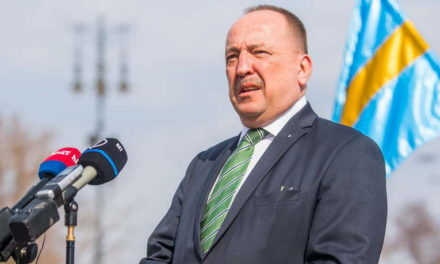Although "everyone" in Székelyföld drinks pálinka, everyone has their own pálinka - which, if it is not him, his father, grandfather, brother, or uncle, it is relatively rare to get hold of a remarkable distillate.
There are fruits that are traditionally the raw material for making brandy. Although plum pálinka is still the most common throughout Transylvania, more and more people are cooking and consuming juice made from peaches, pears or even grapes. Péter Bán, a passionate and recognized hobby brandy maker and expert, is not content with the classics: he also makes brandy from celery, hazelnuts and murk.
Although "everyone" in Székelyföld drinks pálinka, everyone has their own pálinka - which, if it is not him, his father, grandfather, brother, or uncle, it is relatively rare to get hold of a remarkable distillate. Péter Bán from Csíkborzsova tasted the peach pálinka at his children's kindergarten (parents') party, which was a real pleasure to consume, in which he could feel the characteristic notes of the fruit, and which gave him the impetus to immerse himself in the world of brandy brewing. The pálinka maker taught him how to mash, he learned where to get quality fruit, and learned the basics of the profession. At that time, József Bán and his family were still living in a block of flats, where there was no space to operate a cooker, to store fruits and mash, but they slowly got to the point where they managed to move into a house with an orchard.
Székelyföld is also a special region from the point of view of pálinka, and Péter Bán's experimentation quickly bore fruit, he regularly received accolades from friends and acquaintances who tasted his pálinka, so it slowly became clear to him that he could try to compete for his "creations" in Hungary, where pálinkas have a large they have a culture, many people are involved in the industry. Already at the first race, he received feedback that the direction was very good.
"And then I set out on this competitive path to try to see what we can achieve from home, local fruits, at the more famous competitions. Unfortunately, where I live, next to Csíkszereda, there are very wild fruits, old native apples, wild fruits. The judges didn't even know these flavors, the notes of a batul or jonathan apple were completely new to them."
explained Péter Bán. For example, there are 11 varieties of Jonathan apples in Hungary, but none of them are like the ones found in Székelyföld. This is also because the fruit trees in our region are usually very old, up to a hundred years old, while in Hungarian orchards, the trees are usually "maxed out" in 20-30 years, and the given plantation is cut down. In this regard, he told us that he had once smuggled his own preparation into a training course focused on brandy defects, which he attended so that it could be evaluated.
"The person took the glass to his nose and then put it down. He thought for ten seconds, then said that it was a Jonathan apple variety, which came from very old trees, with small fruit, with very deep roots - because the drink contains chemicals that are not in the soil above, only in the deeper layers. He also said that the fruit comes from a very remote, harsh place, not from a fruit-growing region, and added that it is probably from the eastern zone of Transylvania, Udvarhely, or Csíkszék in particular.
- recalled Péter Bán, adding that the person also asked for a bottle of the pálinka so that he could introduce this particular taste world to the Hungarian judges.
Unusual ingredients, familiar flavors
After the fruits came the vegetables. Péter Bán experimented with a wide variety of unusual ingredients. He explained that, for example, a pálinka made from celery tuber or carrot has a special preparation method: the vegetable must be cooked so that the starch in it turns into sugar, and then that sugar must be added. This is followed by further fermentation, and after a few weeks it can be brewed, so that one hundred kilos of vegetables eventually become one to one and a half liters of brandy. The result is a juice that, as Péter Bán says, is meant to be licked, to be savored, not to get the pálinka drinker drunk by downing one glass after another. He adds that many people are very reluctant to try these novelty drinks, but once they try one, they become very interested.
Péter Bán does not make pálinkas for sale: it is very difficult to operate a distillery officially and legally, which is also proven by the fact that, for example, there are only three companies in Hargita County that deal with this (in one of them, by the way, Péter Bán is involved as a silent partner to improve the quality of the products). By the way, larger breweries usually simply ferment the fruit, which, according to Péter Bán, cannot achieve premium quality, because in this case wild bacteria help the process, and it is not controlled, as in a fermentation assisted with special yeast. According to him, a change is slowly being felt in the industry: there are more and more skilled, demanding pálinka makers operating in Érmellék, Szatmár county and Székelyföld, who focus not on quantity, but on quality.
Bad flavors must be deleted
Many people come to Péter Bán for a tasting, but it's more of a culinary experience, not "drinking". He adds that many people bring brandy to him so that he can comment on what he is always a little afraid of, as it can easily end up being insulted.
It is a big challenge to erase old flavors and old defective products from people's minds. In Székelyföld, everyone has pálinka, everyone brews something either himself, or at his grandfather's, or at the neighbors', or it's somehow solved. When someone brings their own brandy, I put my type of product next to it, so the person can decide which one has a pleasant smell, which one is consumer-friendly, doesn't sting, doesn't sting, and which one doesn't need to be immediately printed with something.
And then, when they taste such a plum, everyone is like, wow, I haven't even drunk plum brandy before, that I've been drinking some shit."
he explains. During his experiments, he was not only successful: for example, after tasting an Austrian product, he decided that he would also make brandy from hazelnuts, for which he bought fifty kilos of hazelnuts, but he thought that the first concoction smelled like manure and was undrinkable, so he bought another fifty kilos of hazelnuts. The third attempt brought the expected result, but it was not his favorite either, personally he prefers to drink a good apricot or William pear cognac.
He also said that it is a great pleasure for him when a brandy brings back a memory to a person through its taste. "Murokpálinka" reminds many people of when they ate carrots pulled out of the ground in the garden as children.
"I think the greatest recognition is when something clicks in your head, and from then on, so to speak, you're constantly on the lookout for a sip of murk brandy"
he believes. He also said that he mostly buys the fruit from Hungary, because the farmers in Romania are not yet prepared to serve the "pálinkas" with quality fruit, here mostly the fruit left on the ground meets this fate. In contrast, the Hungarian farmer picks the fruit for the pálinka - by hand - when the chef requests that the taste and ripeness be the way he wants it. He recently made pálinka from pumpkin, the next plan is cantaloupe pálinka, but the limit is the starry sky.
Featured image: Péter Bán/Facebook













